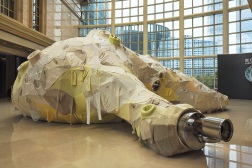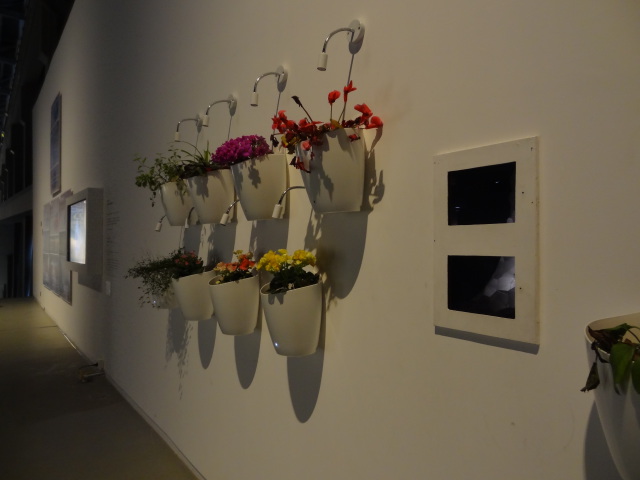
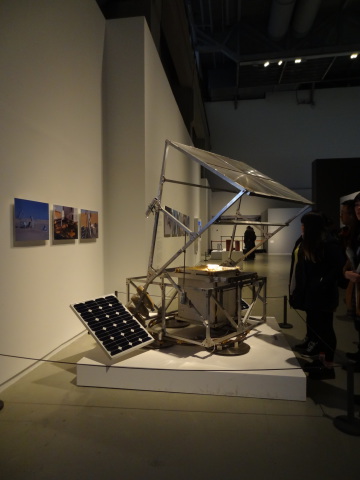

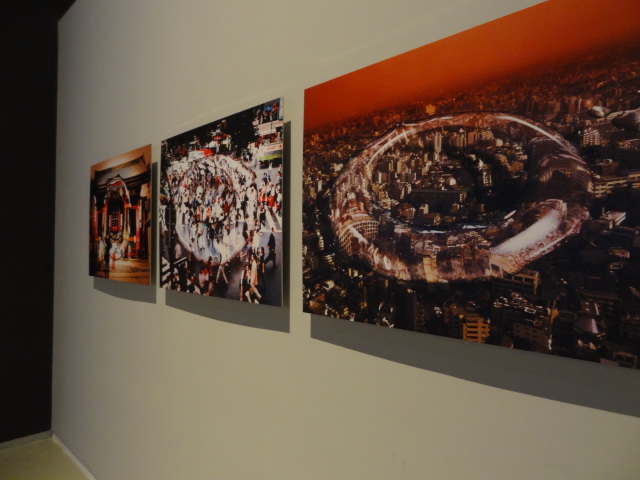
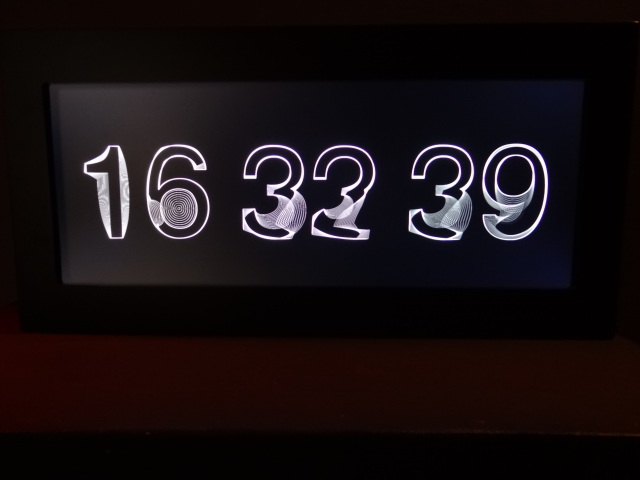
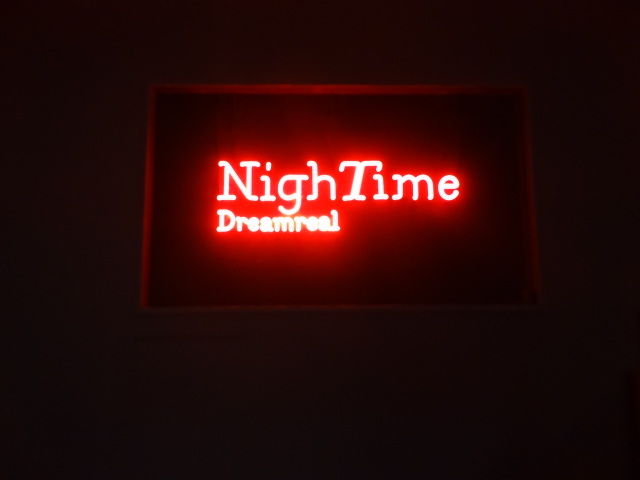

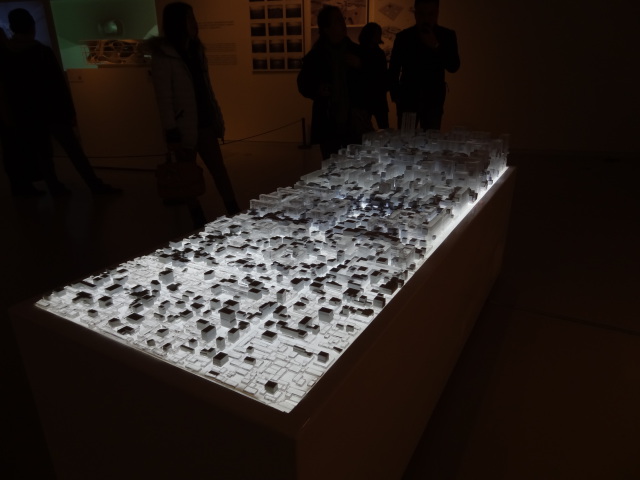

Design Shanghai 2013 Biennale: Aesthetic Cities
Time: 4 December 2013 – 30 March 2014
Venue: Power Station of Art, Shanghai
Urbanization is an on-going process in cities’ life cycle. Among the many factors which impact urban development, “design” is of of the greatest importance. Design not only transforms our daily life through the consumption of products, but also build a behavioral social mechanism through the evolving of the “materiality”, changing the facade and character of the city.
The theme of this year’s Design Shanghai exhibition is Aesthetics City. The theme involves advocating the use of design to realize more creative lives and the use of aesthetics to build an ideal city. Aesthetics is the most distinctive conceptual link between a city and its design. The Aesthetics City exhibition takes a critical focus on issues encountered during the process of urbanization, such as suburban urbanization and counter urbanization. The exhibition explores urbanization models which allow people to live in harmony with nature and which allow both rural and urban areas to prosper.
The exhibition will showcase innovative and inspiring examples from many different regions to locals and visitors, bringing with them new design and life concepts. This will then spur Shanghai’s development as well as China’s art design and creative industries.
Design Shanghai History
Design Shanghai is a biennale that began in 2000 as the Shanghai Design Exhibition and which has six successful exhibitions under its belt to date. It aims to promote the development of creative design in Shanghai, foster innovative and pioneering designers and forge a distinctly Shanghainese cultural brand. Design Shanghai has become a brand event with great influence in its industry within Shanghai art circles.
The sixth Shanghai Design Exhibition in 2011 was organized by the Shanghai Federation of Literary and Art Circles and hosted by the Shanghai Designers Association. The exhibition showcased works by leading designers as well as creative design concepts and laid the foundation for a world-class professional award: the Shanghai Design Award. In order to further Shanghai as an international cultural metropolis and promote the prospering and development of its culture, the 2013 exhibition’s name was changed to Design Shanghai 2013. It will invite Chinese and international designers and endeavor to forge a professional, innovative and trend-setting contemporary art and design biennale.
Invitational Exhibitions
The city is the center of life and this is particularly true of this city of ideas. Cities consist both of individual elements and of the consensus of the many and conventional ways of life. At Design Shanghai 2013, an exploration of cities, design and the features of contemporary aesthetics will be made through the medium of the “city”.
The exhibition will be divided into four conceptual units: Shanghai: Re-Design, Brand Media, Abstract and Concrete and Inter-School Community, analyzing the “city” with concrete examples within a defined time range. Our response to the main theme of the exhibition ‒ the Aesthetics City ‒ is the idea of “urban upgrade.” We explore the critical eye and reforming power of contemporary design on specific eras, analyze the different relationships between current and future trends with which urban upgrade will have to deal, and showcase the important role design has to play in urban upgrade. The concept begins with re-examination of our own knowledge and culture and permeates every aspect of life. Such a comprehensive exploration of the powerful relationship between the city and design and their symbiosis is precisely the challenge faced by contemporary designers.
Shanghai: Re-Design
The city is the central motivating force in design. The different faces of urban life are showcased by Shanghai’s dense clusters of buildings: different eras, the ebb and flow of fashions, redevelopment of districts both old and new, and the clash between elite and grassroots culture. All these have formed the modern city with its diverse, coexisting values. In Shanghai, talented designers gather and compete. Shanghai’s background as a center of fashion and its own traditional culture create constant spread and updating of values while the compiling of a diverse array of information in the city has created uniquely Shanghainese design and creative industries.
Re-design fuses a new introduction, examination, deliberation, and perspective on past experience and will broaden redefinition of designer language with discussions on a series of issues, including “the interaction between design philosophy and design in practice, and urban upgrade and development.” Works by different designers will testify to shifting concepts and upgrades in urban residents’ values, lifestyle improvements, and methods for urban rejuvenation and the synchronized logic affecting the transformation of different industries born from a focus on changing identities. These works will show the unique role that design plays currently in improving the efficiency of urban upgrade.
Abstract and Concrete
Diverse urban lifestyles come from a fusion of professional, abstract principles of design philosophy and the spare-time, more concrete design energy of laymen. This philosophy and energy are themselves a byproduct of the original concept of design.
This exhibit centers on explorative design by independent designers and artists, leaping outside the conventional “design” box and enriching the expressive power of design. The future of design will rely on innovation of thought and an inclusiveness that begins with education. Design should not be trampled by practical requirements. It must break outside of the box and pioneer beyond the bounds of normal thought. When design no longer has a clear goal in mind, designers can perhaps discover brand new possibilities. Nor is design the exclusive property of professional designers: spare-time and non-mainstream creators and those who think outside the box all fall outside the lofty philosophy of design and yet their instinctive, layman creativity may be just the place where design’s potential is tapped.
There should also be a more open discussion between public art and public space. Public art will be displayed through a combination of virtual and concrete space, interacting with the public.
Film City
The Film City exhibit is not a history of cinema of the Aesthetics City. Instead it employs active and interactive media, from the very first exhibit, to narrate a story full of suspense: the story of Shanghai’s urbanization. There are films from the 331 mainly left-wing Shanghai films produced in the Republican era; records of 1967 films lost to history; a detailed view of the portrayal of urban development in global cinema; and documentaries about the destruction wrought on the global environment by both East and West in the pursuit of short term gain. The exhibit also expresses the care and sense of mission of the individual in Professor Stephen Hawking’s Grand Design and the idea of ‘saving for a rainy day.’ Finally, the exhibit allows individual experimental filmmakers to display their keen insights into imagery and philosophy.
The Film City analyzes the omnipresent media of the future from a 360 degree perspective, revealing both prominent and hidden aspects. Ubiquitous surveillance means that as visitors watch history unfold at the exhibit they themselves are the object of attention. When visitors leave, the director’s chair at the exhibit entrance symbolizes how we form our own history by combining the past and the present, narrating it in a calm way.
Craft Design
This part allows us to rediscover the value of handicrafts and experience the wisdom, warmth and individuality of expression present in modern handicraft design. Hand-made products with a modern design will be showcased at the exhibit. As part of the Aesthetics City exhibition, this exhibit aims to emphasize the blending of new design and traditional handicrafts. This will help to re-forge and improve the quality of traditional handicraft products in the modern era, forming a fashionable bridge between the arts and modern life, thereby disseminating the concept of a slower pace of life.
City of Craft Design will form a space to experience handicrafts, telling its own story and focusing on Asian family life. There will be different indoor themes such as the bedroom, the lounge, the kitchen, the dining room and the study, along with activity-themed spaces such as a place where people can drink tea and chat, or a relaxed environment in which people can appreciate the Way of Incense.
Handicraft design is the living cultural hallmark of a city and represents not only a form of art but also aesthetic appreciation and urban culture. In light of this, the exhibit will feature modern-design handicrafts, emphasizing the blending of design and traditional crafts while satisfying modern aesthetics and lifestyles. Materials will be rooted in the local environment, symbolizing the importance of such products in environmental protection and recycling. Handicraft design will focus on creating modest, down-to-earth, unique stories making use of classic visual effects. This will promote the artists, designers and brands involved, propelling the modern idea of handicraft improvement through design innovation and so continue the revival of handicraft art.
NighTime-Dreamreal
NighTime-Dreamreal exhibit invites us on a short but socially significant journey through the darkness of the night. The exhibit transforms urban space and scope and our gaze and pace, attempting to teach us to view the city in a different light, to understand its shape, its life, its language and its identity in the dark. Shanghai’s glow is suspended above the water and where day and night interweave it is like seeing oneself in a mirror. NighTime-Dreamreal exhibit aims to showcase the aesthetic features and moral character of Shanghai, and fuse the two together.
The exhibit explores daily Shanghainese life, in which values from the environment and the great metropolis’ creative imagery are closely knit together. Time, sound, light, movement and space are all themes explored during moonlit strolls in this city and they form an indissoluble whole. All of these themes rely on a two fold exterior of technology and poetic meaning. Without aesthetics there can be no moral character; without dreams there is no reality; without tumult there can be no compromise. The city is a fluid entity that changes with time. Its light pours forth its poetry, economy, rhythm and imagery.
NighTime-Dreamreal exhibit also asks viewers to realize that a city only exists because of the people who observe it and live in it. A city may be pragmatic, or full of vitality, or active in protecting the environment. The exhibit invites the collective as well as the individual on a journey through theme tropolis that combines the entire urban vista with individual cultural experience. The exhibit employs design to appropriate fantasy and reality, exploring the mundane and the bizarre, all in order to guide people towards a new and prosperous future, ensuring they are not forgotten by this city.
Alcantara launches Sliding colors by Massimilano Adami during the Design Shanghai 2013 Biennale
Alcantara, the Made in Italy material which is the preferred choice of the creative avant-gardes, is the protagonist of Sliding Colors, the installation created by Massimiliano Adami for the Design Shanghai 2013 biennale event.
On the occasion of Design Shanghai 2013, Aesthetics City, Alcantara is the partner of Triennale Design Museum exhibition and presents an installation designed by the Italian designer Massimiliano Adami and entirely created in Alcantara material.
Sliding Colors
Thinking of Alcantara not as cover but as a structural material to be moulded and sculpted so as to define visionary, almost psychedelic spaces that highlight the chromatic variety of this new material, which cannot be classified according to classic parameters. It belongs to its own category that is unlike any other, neither natural nor artificial. This is the object of the new project that Massimiliano Adami has devised for the brand.
The designer created a moving installation representing the way natural elements change continuously, an ideal metaphor for the variety of the Alcantara range. He created a space using circular partitions inside which move Alcantara strips in different colours and finishes. They can be seen through holes shaped like plain and ocean isopleth contour lines. A soft space that offers a three-dimensional perceptive emotion, as cocooning as space travel amidst the clouds. The colours pass slowly, changing into ever-new shapes, one over the other like a kaleidoscope in order to illustrate the multifaceted repertoire of this strong, breathable, pliable, soft material available in a truly incredibly vast range of shades. Those chosen for the installation are the pale tones of the air, warm earthy hues and the blues of water.
The spark that lit the fervid imagination of Massimiliano Adami, a modern alchemist of hi-tech materials, was a picture of the Visiona 2 Temporary installation made by Verner Panton for Bayer at the 1970 annual furniture fair in Cologne. Alcantara’s unique qualities are ideal for giving shape to futuristic visions inspired by the utopian conceptualisations of the 1970s. Sliding Colors depicts an approach to interiors considered as a total space involving the greatest chromatic freedom.
Starting with Verner Panton’s vision, Massimiliano Adami’s installation goes further and offers almost movie-like Technicolor effects designed to present, in a moving image, the variety of the Alcantara range. It immerses the viewer in a swirl of visual and tactile sensations. Touch is also represented by a series of cylindrical seats, hollow trunks reminiscent of rolls of Alcantara; inside them are layers of material in different colours which sculpt the volume of the seats designed for relaxing and enjoying the performance of Sliding Colors.
Curated by Silvana Annicchiarico – Triennale Design Museum
Design Shanghai Organizers:
Shanghai Federation of Literary and Art Circles
Shanghai Municipal Culture, Radio Broadcasting, Film and Television Administration
Shanghai Municipal Education Commission
Hosted by:
Shanghai Designers Association
Power Station of Art
Co-hosted by:
Shanghai Dongbao Culture Operation Ltd
Supported by the Italian Consulate in Shanghai
